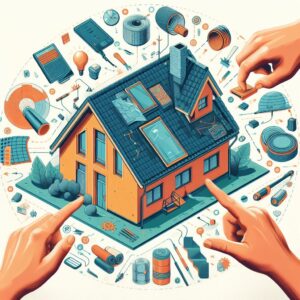 Recognizing the dire need for sustainability and environmental consciousness, the roofing industry has undergone significant changes. There is a growing trend of employing eco-friendly materials and designs in construction, reflecting a commitment to minimize one’s carbon footprint while ushering a sustainable future. This alteration is proven to be not just necessary, but also popular among consumers and builders.
Recognizing the dire need for sustainability and environmental consciousness, the roofing industry has undergone significant changes. There is a growing trend of employing eco-friendly materials and designs in construction, reflecting a commitment to minimize one’s carbon footprint while ushering a sustainable future. This alteration is proven to be not just necessary, but also popular among consumers and builders.
One of the commendable evolutions in this sphere is the preference for recycled roofing materials. Derived from waste such as scrap metal, plastic, and rubber, these materials exhibit resilience and high durability, even under extreme climatic conditions. They have the potential to offer long-term value for money, making them a worthwhile investment for any concerned homeowner. Their growing popularity can be attributed to their sustainability, practicality, and economic viability.
There has also been a marked increase in the adoption of green roofs, also known as living roofs. These innovative structures are characterized by a layer of vegetation that flourishes on the rooftop, transforming it from a mere protective cover to a living ecosystem. The benefits of green roofs extend far beyond aesthetics. They promote superior insulation, resulting in significant energy savings and an optimized indoor environment.
Green roofs also enhance the quality of air by filtering pollutants and releasing oxygen. They make a crucial difference in moderating the urban heat island effects, a common phenomenon in congested cities. The vegetation on the roofs also serves as a habitat for local biodiversity, thereby enhancing the local ecology.
Green roofs are gaining wide recognition and endorsement from architects, builders, homeowners, and environmentalists around the world. The cumulative support for these sustainable solutions has contributed to their rising popularity, making them mainstream rather than niche. They signal a positive shift towards environmental responsibility and cultural sensitivity, aligning the interests of construction and conservation.
A cleaner and greener future may not be far off, with the roofing industry taking bold steps in the right direction. The adoption of such eco-friendly practices and materials is catalyzing a necessary change in the industry, making it more in sync with nature and its resources. This change is not just beneficial for the environment but also proves to be profitable for people and their pockets. It has been a dual victory, balancing the economic aspect with moral responsibility towards the planet.
It can be stated without any doubt that eco-friendly roofing options are not just a fad. They are here to stay, and rightly so, given the multitude of benefits they extend to people and the planet. They have successfully ‘stolen the spotlight’ in the construction industry. Not surprisingly, they are likely to become the norm rather than an exception in the near future.
Innovative Roofing Materials Promise Durability and Style
 As we shift into 2023, the innovations in roofing materials are noteworthy. Advances in technology, sustainability, architectural aesthetics, and durability have led to radical changes in roofing trends. Metal roofs are generating substantial buzz in the industry, primarily due to their impressive lifespan extending to approximately 70 years, rivaling traditional materials like asphalt shingles. Destined to leave a mark, corrugated metal designs, cool metal roofing, and metal tiles stand out for their ultramodern, refined aesthetic, making them a popular choice among architects and homeowners alike. Another key attribute is the enhancement of energy proficiency, marking a definitive step forward into safe and sustainable housing.
As we shift into 2023, the innovations in roofing materials are noteworthy. Advances in technology, sustainability, architectural aesthetics, and durability have led to radical changes in roofing trends. Metal roofs are generating substantial buzz in the industry, primarily due to their impressive lifespan extending to approximately 70 years, rivaling traditional materials like asphalt shingles. Destined to leave a mark, corrugated metal designs, cool metal roofing, and metal tiles stand out for their ultramodern, refined aesthetic, making them a popular choice among architects and homeowners alike. Another key attribute is the enhancement of energy proficiency, marking a definitive step forward into safe and sustainable housing.
Next to gaining popularity are solar tiles, another significant innovation that deserves mention. Diverging from the conventional rooftop solar panel system, they are a more sophisticated and covert alternative. Ensuring aesthetics are not compromised, these tiles blend in with the general roof design making them virtually unnoticeable. The crux of their design lies in the ingenuity of integrating solar technology with roofing tiles, adding dual functionality and increasing efficiency. By transforming sunlight into electricity, they provide an innovative and practical solution to escalate the shift toward renewable energy. Balancing functionality and design aesthetics, these solar roofs are a commendable way of offsetting energy costs.
Aspiring to be more than just a protective canopy over our heads, modern roofing techniques driven by technological advancements are capturing the essence of durability, eco-friendliness, and style. They are about transforming rooftops from being mere overhead structures into functional, productive assets while keeping the aesthetic quotient intact. This reflects a larger movement towards sustainable architecture and energy independence, shaping the houses of tomorrow.
As the dynamics of architectural design evolve, these innovations present a promising future for the roofing industry. With metal roofs and solar tiles at the forefront, the future of roofing seems technologically advanced, sustainable, and more diversified than ever before, promising a blend of longevity, energy generation, and trendsetting designs. Undeniably, these are exciting times for the roofing industry, with continuous innovations pointing to an era of dynamic and strategic shifts. Whereas roofing once used to just about protecting homes from the elements, it is clearly becoming a statement of style, efficiency and forward-thinking.
Technological Breakthroughs in Roof Installations
The field of roofing is undergoing significant remodeling, spurred on by technological breakthroughs. With the dawn of 2023, it’s anticipated that the use of drones to conduct roofing surveys will be on the rise. These automated flying machines deliver high-resolution images of roofs, play an instrumental role in spotting damages, and are efficient in estimating roofing costs. The upshot is a notable increase in safety for those working in the roofing profession because they no longer have to carry out manual inspections. It’s a win-win situation for everyone involved because homeowners also accrue cost savings.
The narrative on technology and roofs does not stop there. Thermal imagery is another novel technique in line for mass adoption. This state-of-the-art method makes it possible to locate areas where heat loss is excessive. This swift identification of insulation problems translates into considerable energy-saving rewards, thus providing a definitive answer to roofing challenges that have been troubling the world for a long time.
An essential cog in the modernization of roof installations is the emergence of 3D printing technology. With its capacity to produce intricate designs rapidly, this technology is set to revolutionize the roofing industry. Thanks to this advancement, roofs can now be installed faster and with increased accuracy.
Technology is also poised to revolutionize maintenance practices. Traditional ways of maintaining roofs are characterized by high labor costs and inefficiency. However, by integrating modern technology, maintenance processes are made faster, and more efficient, thus resulting in significant cost savings to homeowners.
The roofing industry is on an upswing, driven by rapid technological advancements. As the world marches steadily into 2023, heightened utilization of technology in roof installations is expected to become more and more evident. This not only underscores the indispensability of technology but it also points out the benefits that its proper adoption brings to various sectors.